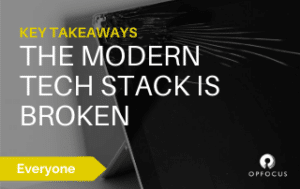The Modern Tech Stack is Broken
 It’s no secret the tech stack is an important part of a companies success. But how often does your team take a hard look at what you have, and how it compares to your companies needs? Most organizations have apps they no longer use or aren’t using to the fullest. For this reason, Justin Browne, Phil Lacorte, and Venketesh Iyer believe the Modern Tech Stack is Broken. We’ve outlined the key takeaways from their discussion during Workato’s latest webinar.
It’s no secret the tech stack is an important part of a companies success. But how often does your team take a hard look at what you have, and how it compares to your companies needs? Most organizations have apps they no longer use or aren’t using to the fullest. For this reason, Justin Browne, Phil Lacorte, and Venketesh Iyer believe the Modern Tech Stack is Broken. We’ve outlined the key takeaways from their discussion during Workato’s latest webinar.
Prioritizing Technology Investments:
It’s important to prioritize how your team spends its time and invests its money. To assist with this, the panelists provided an overview of how organizations should prioritize their technology investments. This ensures your team is addressing the issues that have the largest impact on your business. The panelists broke this process down into 3 points.
Work backward from your problems
Your team should always start with the problem you’re looking to solve, then look for a tool that will address it. Some teams bring on tools without first identifying an issue. This often leads to redundancies and ultimately wasted investments.
Prioritize your problems
It’s important to address your team’s most pressing issues first. You always want to reduce the amount you invest in the tech stack so it’s important to tackle the most important issues first. After these problems are addressed, less vital issues should be looked at.
Think about your end audience
Your tech stack is designed to help users. It needs to be built in a way that works for them, makes them more productive, and addresses the problems they face. By receiving feedback from a group of end-users, you can ensure they’re being provided what they need and can be successful.
Building on a Broken TechStack
A lot of teams do an evaluation and find their tech stack could be improved. So, how do you build on a broken tech stack? The discussion on this topic focused on three key points. By following this advice, the panelists believe teams can successfully improve their tech stack.
Understand your commission cost
It’s important your team has a firm understanding of costs. Since a large part of costs comes from the commission structure, you’ll need to have an intimate understanding of how it’s set up. By doing this, your team can make more informed decisions.
Pushing back on buying tools
The easiest solution is always to buy a new tool that addresses your issue. This is not always the best move, too many tools cause redundancies, increase costs, and make the tech stack more difficult to manage.
Finding a single source of truth across departments
Every team needs access to reliable and trusted data. Creating one location that’s accessible across the company is the easiest way to accomplish this. Doing so ensures every department is on the same page and has faith that the data they’re using is reliable.
How many tools are too many?
This is an important question. It’s easy to buy a new tool for each new problem but at a certain point, there’s too many to manage. Justin believes there are too many “When I start having shelfware and I’m not getting value from all the tools. A lot of companies are evaluating how much they are spending on tools and the value they’re getting from them. There is no golden rule.” He does a great job describing how a tool should provide value. As soon as the tool’s not worth the cost, that’s an indicator there may be too many. Question one you should ask when considering a new tool is “Do I need a new tool?” Often times you’re able to solve problems with your current tech stack. You may simply need an integration between your existing applications.
How should I Evaluate Tools?
As your team evaluates a tool, Phil Lacorte suggests you consider the future, not just your immediate needs. “’When I buy a tool, I am doing it to solve an issue, but I want to think holistically. I go to a vendor with a list of metrics I am looking to improve. When I go into my evaluation I am thinking of other areas this tool will affect.” His advice ensures your team is looking beyond the one issue at hand and considering the tech stack as a whole. Ideally, you’ll be able to solve multiple issues with a single solution, or the solution can scale with your company as it grows.
When is a tool expendable?
A lot of teams have questions around how to evaluate when a tool is expendable. There are many ways to go about this evaluation but a simple idea the panelists presented was asking the questions
- What would be the business impact if we shut this off right now?
- How many people will notice the tool is turned off?
- Will people be angry if it’s turned off?
You may or may not want to actually turn off a particular tool depending on how the tech stack is integrated, but as a simple evaluation criterion, asking these questions is a good place to start.
Closing Advice:
To end the session, each panelist presented some parting advice. Here’s what each panelist had to say:
Venketesh – “If you are an early-stage company and trying to evaluate a tool, look at things that will directly impact your customer and revenue. If you are a mature company, look at tools for operational excellence.”
Phil – “If there is a problem in your tech stack, don’t wait, go after it and deal with it. It will save money in the long term, increase productivity, and help you scale.”
Justin – “Think business objectives. Really question if you need one more thing. Constantly evaluate your needs and how the tech stack meets them.”
Final Thoughts
As the discussion around how the modern tech stack is broken came to a close, it became clear how much attention should be paid to the tech stack. OpFocus understands the value of an effective tech stack and how it impacts the way your team operates. If you believe your modern tech stack is broken, we’d like to get in touch. Our team has experience creating a plan tailored to your needs that will help you reach your operational goals.



